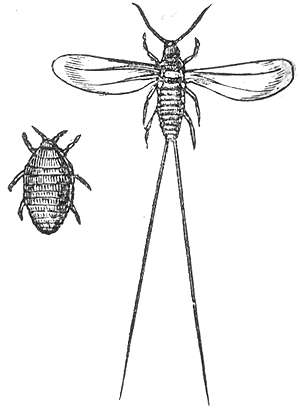Cochineal
(kotch' -in-el or kotch-in-el') [ME., cutchaneal].
Cochineal[edit | edit source]
Cochineal refers to a species of scale insects, specifically Dactylopius coccus, that are native to Central and South America. These insects are known for their vivid red color and have been used for centuries as a source of natural red dye. Cochineal dye, derived from the crushed bodies of female cochineal insects, is highly valued for its intense and durable red pigment. In this article, we delve into the history, cultivation, extraction, uses, and cultural significance of cochineal.
History[edit | edit source]
Cochineal has a long history of use as a dye by indigenous peoples in Central and South America. The Aztecs and the Incas were among the first civilizations to utilize cochineal as a dye, primarily for coloring textiles and body adornment. The use of cochineal spread to Europe after the Spanish conquest of the Americas, where it became highly sought after and was even considered more valuable than gold.
Cultivation[edit | edit source]
Cochineal insects are cultivated on the pads of certain species of cactus, particularly the nopal cactus. The female cochineal insects, known as "grana," are collected from the cactus pads and used for dye extraction. The cultivation of cochineal requires careful attention to the growing conditions of the cactus, such as adequate sunlight and water.
Extraction of Cochineal Dye[edit | edit source]
The process of extracting cochineal dye involves several steps:
Harvesting: The mature female cochineal insects are carefully brushed or harvested from the cactus pads.
Drying: The harvested insects are dried either under the sun or in specialized drying facilities. This process reduces the moisture content and prepares them for grinding.
Grinding: The dried insects are ground into a fine powder using mortar and pestle or mechanical grinders. The resulting powder is the cochineal dye.
Processing: The cochineal powder can be further processed to extract the dye. This can involve techniques such as soaking the powder in water or other solvents, filtering the liquid, and evaporating the solvent to obtain the concentrated dye.
Uses[edit | edit source]
Cochineal dye is primarily used as a natural coloring agent in various industries:
Textiles[edit | edit source]
Cochineal has been used for centuries to dye textiles, including fabrics, yarns, and fibers. The dye produces a wide range of shades, from vibrant reds to deep purples, depending on the mordants and techniques used during the dyeing process. Cochineal dye is known for its excellent lightfastness, meaning it retains its color even after prolonged exposure to sunlight.
Food and Beverages[edit | edit source]
Cochineal dye, known as carmine or E120, is used as a natural food coloring in many food and beverage products. It is commonly found in red candies, desserts, beverages, and processed foods. Cochineal is prized for its bright red color and is considered a natural alternative to synthetic food dyes.
Cosmetics and Pigments[edit | edit source]
Cochineal dye is utilized in the cosmetics industry to create various shades of red, pink, and purple. It is found in lipsticks, blushes, eyeshadows, and nail polishes. Cochineal is also used in the production of artist pigments, providing a wide range of red hues for painters and other artists.
Cultural Significance[edit | edit source]
Cochineal has cultural significance in the history and traditions of many indigenous communities in Central and South America. It has been used in rituals, ceremonies, and artistic expressions. The vibrant red color symbolizes vitality, life, and abundance.
References[edit | edit source]
See Also[edit | edit source]
Natural Dye Textile Dyeing Cactus Food Coloring Cultural Significance of Colors
Search WikiMD
Ad.Tired of being Overweight? Try W8MD's physician weight loss program.
Semaglutide (Ozempic / Wegovy and Tirzepatide (Mounjaro / Zepbound) available.
Advertise on WikiMD
|
WikiMD's Wellness Encyclopedia |
| Let Food Be Thy Medicine Medicine Thy Food - Hippocrates |
Translate this page: - East Asian
中文,
日本,
한국어,
South Asian
हिन्दी,
தமிழ்,
తెలుగు,
Urdu,
ಕನ್ನಡ,
Southeast Asian
Indonesian,
Vietnamese,
Thai,
မြန်မာဘာသာ,
বাংলা
European
español,
Deutsch,
français,
Greek,
português do Brasil,
polski,
română,
русский,
Nederlands,
norsk,
svenska,
suomi,
Italian
Middle Eastern & African
عربى,
Turkish,
Persian,
Hebrew,
Afrikaans,
isiZulu,
Kiswahili,
Other
Bulgarian,
Hungarian,
Czech,
Swedish,
മലയാളം,
मराठी,
ਪੰਜਾਬੀ,
ગુજરાતી,
Portuguese,
Ukrainian
Medical Disclaimer: WikiMD is not a substitute for professional medical advice. The information on WikiMD is provided as an information resource only, may be incorrect, outdated or misleading, and is not to be used or relied on for any diagnostic or treatment purposes. Please consult your health care provider before making any healthcare decisions or for guidance about a specific medical condition. WikiMD expressly disclaims responsibility, and shall have no liability, for any damages, loss, injury, or liability whatsoever suffered as a result of your reliance on the information contained in this site. By visiting this site you agree to the foregoing terms and conditions, which may from time to time be changed or supplemented by WikiMD. If you do not agree to the foregoing terms and conditions, you should not enter or use this site. See full disclaimer.
Credits:Most images are courtesy of Wikimedia commons, and templates, categories Wikipedia, licensed under CC BY SA or similar.
Contributors: Kondreddy Naveen


